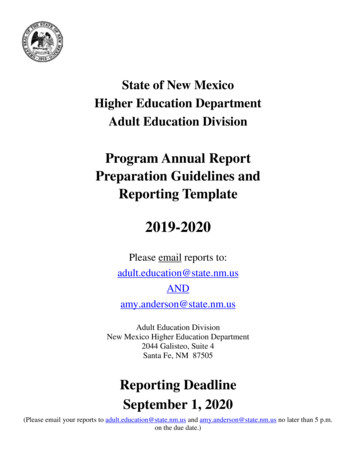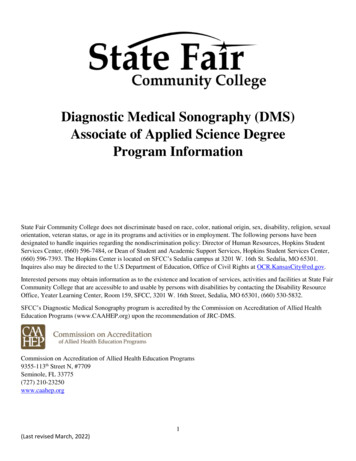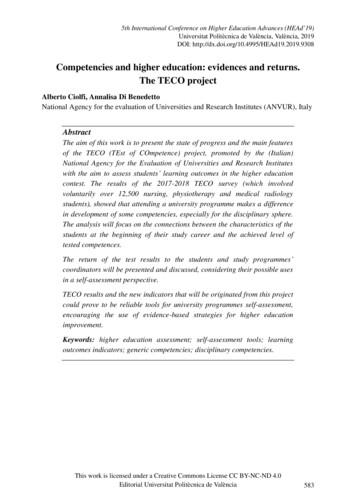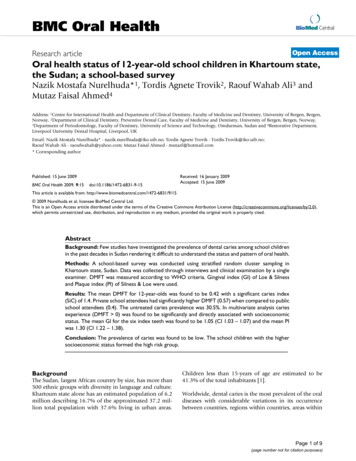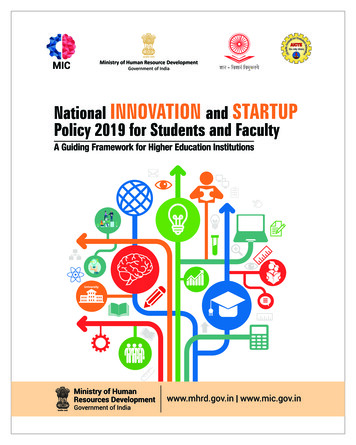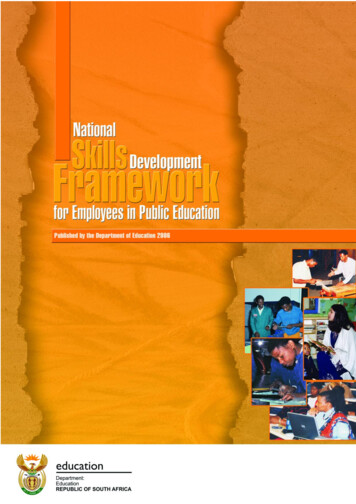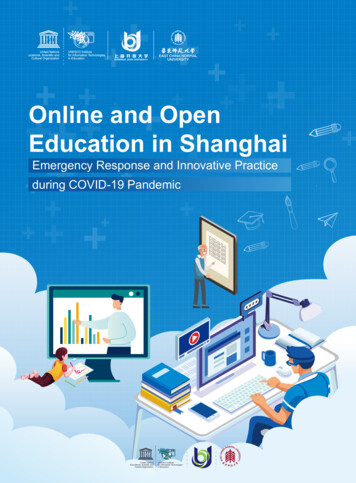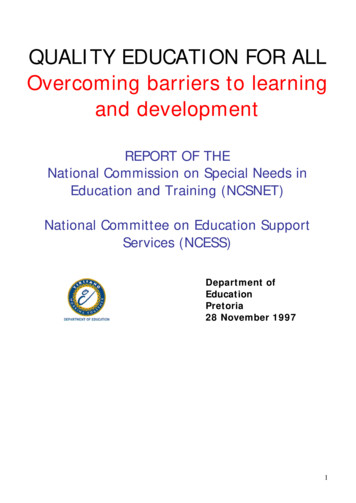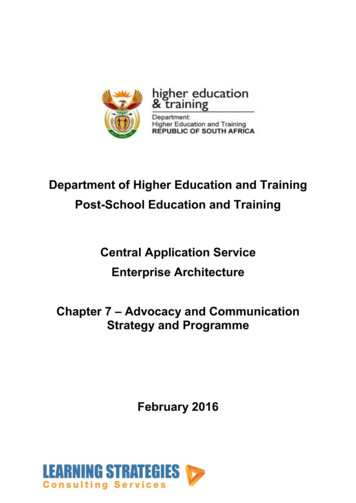
Transcription
Department of Higher Education and TrainingPost-School Education and TrainingCentral Application ServiceEnterprise ArchitectureChapter 7 – Advocacy and CommunicationStrategy and ProgrammeFebruary 2016
Post-School Education and TrainingCentral Application ServiceEnterprise ArchitectureChapter 7 - CAS Advocacy and CommunicationStrategy and ProgrammeFebruary 2016Contents1Terms of Reference . 12Advocacy and Communications in Context . 12.1Purpose and Objectives . 12.2Project Phases . 12.3Communications versus Advocacy . 23Stakeholder Map . 34Communication and Advocacy to Date. 34.1Pre Phase 1 Activities . 34.2Phase 1 Activities . 45Advocacy Strategy and Programme . 66Communications Strategy . 77896.1An Integrated Approach. 76.2Branding and Message . 8Overall Communication Plan . 87.1Pre-Launch Communication . 87.2Launch of the CAS . 87.3Annual Application Cycle . 97.4PSET Sector Roll Out . 9Stakeholder Communications Plan . 98.1Applicants . 98.2Parents . 108.3Schools . 118.4Institutions. 118.5Service Providers and Information Providers . 12Communication Mechanisms and Tools . 149.1Handbook . 14i
Post-School Education and TrainingCentral Application ServiceEnterprise ArchitectureChapter 7 - CAS Advocacy and CommunicationStrategy and ProgrammeFebruary 20169.2Online Application Process. 149.3Social Media . 149.4Applications App . 159.5Outreach Services . 1510Driving Online Applications . 1511Advocacy and Communication Programme . 1612Conclusion . 17ii
Post-School Education and TrainingCentral Application ServiceEnterprise ArchitectureChapter 7 - CAS Advocacy and CommunicationStrategy and ProgrammeFebruary 20161Terms of ReferenceThis Advocacy and Communication Strategy and Programme has been prepared byLearning Strategies as part of the assistance to the Department of Higher Education andTraining for the development of an Enterprise Architecture as phase one for a National PostSchool Education and Training (PSET) Central Applications Services (CAS).This chapter completes step 5.1 of the Project Plan and presents deliverable number 4.7 asper the Terms of Reference and forms chapter 7 on the consolidated CAS EnterpriseArchitecture.The purpose of this chapter is to present an advocacy and communication strategy andprogramme for the implementation of the CAS based on the current understanding andEnterprise Architecture design for the intended entity. The advocacy and communicationstrategy includes the steps necessary to validate the design and recommendations with thevarious project consultative and advisory structures established for this phase of the project.22.1Advocacy and Communications in ContextPurpose and ObjectivesThe establishment of the CAS for the PSET sector will be a complex and extended projectwhich will touch on a broad range of stakeholders and interested and affected parties.Crucial to the success of the implementation will be the extent to which these variousstakeholders and other parties are brought on board and kept informed of the project andprogress throughout the design, development and implementation phases.Communication with these stakeholders has both the objective of informing them but also ofconvincing them to play an advocacy role on behalf of the project. The direct engagementwith various stakeholders will be through individuals such as executives and registrars atuniversities as well as college principals and SETA CEOs. These individuals will need to bein a position to pass on these messages to their various constituencies and organisationsfulfilling an advocacy role on behalf of the CAS project.At the same time, the CAS project itself needs to consult with and convince a number ofgovernance and regulatory structures of the importance and the potential benefits of theCAS, effectively fulfilling direct advocacy role in this regard.Once established, the CAS will be expected to manage extensive on-going communicationwith various stakeholders. In particular, the annual application cycle will require extensivecommunication at various stages to applicants, parents, schools and other parties engagedin this process.This advocacy and communications strategy is designed to support these processesthroughout the various phases of the project, and provide the basis for the communicationsand outreach processes for the established CAS.2.2Project PhasesThe project for the establishment of the CAS can be broadly broken into three main phaseswith a number of additional sub-phases as follows:1
Post-School Education and TrainingCentral Application ServiceEnterprise ArchitectureChapter 7 - CAS Advocacy and CommunicationStrategy and ProgrammeFebruary 2016 2.3Phase 1: Project for the Establishment of the CAS – this project, is the entirephase leading up to the establishment of the entity and the launch of the CentralApplications Service. The sub-phases in this phase are as follows:oPhase 1.1 - Enterprise Architecture (Currently under way)oPhase 1.2 – Detailed DesignoPhase 1.3 – Legislative EstablishmentoPhase 1.4 – Build and Establish Phase 2: Launch and Roll-out the CAS – this phase, which takes place oncompletion of the establishment project, is effectively the launch of the CAS as anoperating entity and the Roll-out of the service to the various stakeholders. Phase 3: Business as Usual – on completion of the launch period, the CAS willmove into a business as usual phase which will still require extensivecommunication and advocacy on an ongoing basis.Communications versus AdvocacyThis strategy covers both advocacy and communications, and for the purpose of thisdocument these concepts are defined as follows: Communication – Communication is defined as the imparting or exchanging ofinformation by speaking, writing or using other medium. It is the process of sharinginformation with various interested parties aimed at informing them of progress,developments and status of an entity, project or other activity. Communication cancarry various messages and have various purposes including the following:oInformation – merely the sharing of information.oAction – encouraging action from the receiver of the communication such asencouraging individuals to apply early or how to apply.Advocacy – advocacy is defined as the process of obtaining public support for orthe recommendation of a particular cause or policy. Advocacy is also defined asthe act of pleading for, supporting or recommending a cause or proposal.In the case of the CAS, advocacy is therefore an element of the communicationsstrategy but specifically aimed at communicating with those stakeholders beingindividuals and entities that are required to support the establishment of the CASand the operations of the CAS once established.2
Post-School Education and TrainingCentral Application ServiceEnterprise ArchitectureChapter 7 - CAS Advocacy and CommunicationStrategy and ProgrammeFebruary 20163Stakeholder MapAs part of the formulation of the CAS project, a stakeholder map has been formulated asfollows;Career FairsPrivateCDS/NCAPCareerGuidanceDHET Regional OfficesDBEDoLLibrariesNYDAPoints ofPSET entral ApplicationServiceApplicantsOut rsSchoolsPublicApplicant BESARSCIENLRDIEBHome Affairs“Service Providers”NSFInstitution FacingIt should be appreciated that the full ambit of stakeholders of the CAS project is extensiveand that the stakeholder map above is a simplification of this environment by groupingstakeholders as far as possible where engagement and communication messages would besimilar.The stakeholders have been grouped into three broad categories as follows: Applicants and applicant facing stakeholders Service providers Institutions and institution facing stakeholdersAn advocacy strategy has been developed for relevant stakeholders and a communicationplan and strategy has then been formulated for the various phases of the project for eachrelevant stakeholder.4Communication and Advocacy to DateThis section presents the steps already taken aimed at advocacy and communication of theCAS project and process up to the middle of the first phase of the CAS project for thedevelopment of the enterprise architecture. These steps can be summarised as follows:4.1Pre Phase 1 ActivitiesThe concept of the Central Applications Service has been discussed and debated over anumber of years in various forums and task teams. The Education White Paper 3 (DOE:1997) proposed the National Higher Education Information and Application Service(NHEIAS). The National Plan for Higher Education (NPHE), 2001, reaffirmed this proposal3
Post-School Education and TrainingCentral Application ServiceEnterprise ArchitectureChapter 7 - CAS Advocacy and CommunicationStrategy and ProgrammeFebruary 2016and led to the appointment of a working group in October 2001 completing its report by June2002.In 2011, the Minister of Higher Education and Training requested the Council for HigherEducation (CHE) to advise him on the establishment of a CAS. This resulted in a reportdated September 2011 which supported the establishment of a CAS based on the potentialbenefits of such a service and system for all first-time entry undergraduate students intohigher education and training institutions.The 2013 White Paper for Post-School Education and Training reiterated that the newCentral Applications Service is a crucial move towards supporting informed access touniversities and other post-school opportunities for students. The White Paper effectivelybroadened the focus of the CAS to all parts of the PSET sector.The White Paper then led to establishment of the CAS Vision 2030 document which presentsthe vision for the CAS for the PSET sector. The process of developing this vision was thestart of the advocacy and sector-wide communication of the objectives and potential of theCAS in the sector.4.2Phase 1 ActivitiesPhase 1 of the project aims at the formulation of the Enterprise Architecture for the CAS andhas extended the advocacy and communication with various stakeholders primarily throughthe following means: An advisory group has been established including representatives from the variousPSET sectors which has met at key stages throughout the project to receive firstthe service model and then the business and operating model for the CAS. Thishas been a key engagement process as it includes representatives of the varioussectors.At the same time, the Enterprise Architecture project has consulted directly withvarious forums including the following:oUniversities Registrars Forum – the Registrars Forum of Universities SouthAfrica is a key stakeholder body which was engaged fully on the service modelon 28 July 2015 and will again be consulted in detail before the finalisation ofthe Enterprise Architecture.oThe VSET branch of the Department of Higher Education and Training hasbeen engaged with directly aimed at sharing the objectives of the CAS and theimplications for that sector as the CAS evolves over time. The CAS projectteam has requested the opportunity to engage directly with the collegeprincipals but this opportunity has not yet materialised.oIn the Skills Sector (Occupational Training and Skills Development), theconsultation has been limited to engaging with the DHET Skills branch and apresentation to the SETA CEOs Forum.In addition to the above, the project has consulted directly with a number of specificinstitutions including: The KZN Central Applications Office – being the current central applicationsservice for the KZN institutions. NSFAS – a number of engagements with NSFAS have been held aimed atunderstanding the relationships between the proposed CAS and NSFAS and theopportunities for collaboration in the future.4
Post-School Education and TrainingCentral Application ServiceEnterprise ArchitectureChapter 7 - CAS Advocacy and CommunicationStrategy and ProgrammeFebruary 2016 Engagement with Individual Universities – the CAS project team is engageddirectly with individual institutions including the following:oUniversity of WitwatersrandoUniversity of JohannesburgoUNISAoUniversity of LimpopooInformal engagement has also taken place with registrars of other institutionssuch as NMMU.The format of this communication and engagement has been primarily through thepresentation of progress and concepts utilised in the formation of the Enterprise Architectureof the CAS. It should be appreciated that this process is an evolving process and that adefined message in terms of the form and structure of the CAS was still in the developmentphase during these engagements.The completion of phase 1 of this project involves the final delivery of the EnterpriseArchitecture which is anticipated to involve a number of specific consultations as follows:Stakeholder GroupProposed EngagementRegistrars ForumThe final draft of the Enterprise Architecture will be presented infull to the Registrars Forum before the end of March 2016 with afull opportunity to engage fully in the proposed EnterpriseArchitecture and to receive the inputs and advices of theregistrars of the university sector.Regionalengagement withuniversitiesIt is expected to present the CAS Enterprise Architecture to anumber of regional associations which will provide access to theregistrar and various executives of institutions in each region.These consultations will take place between February and April2016 and it is hoped to create the opportunity to directly addressas many as possible of the institutions through thesemechanisms.Individual institutionconsultationThe existing individual institutions will be consulted directly wherepossible and where requests for such consultation can beaccommodated.TVET Sector andcollege principalsA presentation will be made in the first quarter of 2016 to theTVET colleges highlighting the CAS Enterprise Architectureproposals and the timeframes for the potential roll out of thisprocess to the TEVT sector.SETA CEO ForumThe skills sector will be addressed through engagement with theSETA CEO forum also in the first quarter in 2016.In all of the above cases, a comprehensive presentation of the Enterprise Architecture, itsimplications for the various sectors, the proposed rollout plan and the various componentsof the service itself will be presented and discussed.The above effectively comprises the advocacy strategy for the CAS project during theremaining course of phase 1 of the project itself.5
Post-School Education and TrainingCentral Application ServiceEnterprise ArchitectureChapter 7 - CAS Advocacy and CommunicationStrategy and ProgrammeFebruary 20165Advocacy Strategy and ProgrammeFollowing the completion of phase 1 of the project, it is proposed that the advocacy strategyand programme should adopt the following approach:Key StakeholderAdvocacy ObjectiveAdvocacy ApproachDepartment ofHigher Educationand TrainingThe DHET is a key stakeholderand it will be critical to receivethe buy-in and support for theproposed structure andestablishment approach for theCAS from all key stakeholderswithin DHET. The objective istherefore to inform the heads ofall of the branches within DHETof the proposals for theestablishment of the CAS and tokeep them abreast ofdevelopments throughout theestablishment process.The advocacy approach in this casewill be through the branchresponsible for the establishment ofCAS to engage directly with theindividual branches within DHET toensure the other branches areinformed and supportive of the CASproposals.UniversitiesAs universities will be the first tocome on board in the CAS, it isessential that the advocacyapproach ensures the support ofall universities for the proposalsfrom the outset.The advocacy approach will betargeted at multiple levels withinuniversities including:TVET collegesand other collegesTVET and other colleges willfollow the university sector and aspecific strategy will bedeveloped in due course for theadvocacy engagement with thissector. University Vice Chancellorsthrough the structure availablewithin Universities South Africa The Registrars Forum ofUniversities South Africaensuring direct engagement withall registrars with all universities.The Applications andAdmissions Office of alluniversities through informationshared by the Registrars Forumto these offices. The Information Technologydivisions of all universitiesthrough targeted specificinformation aimed at informingthem of the approach, timingand implications on institutionsand setting out clear timeframesfor the direct engagementrequired with institutions fromthe CAS project.The primary engagement will bethrough the VSET branch of DHETand the College Principal’s forumbut with other supporting structuresand vehicles as required to meetthese requirements. As this will besometime into the future, it isproposed that the detailed advocacystrategy for this sector be developed6
Post-School Education and TrainingCentral Application ServiceEnterprise ArchitectureChapter 7 - CAS Advocacy and CommunicationStrategy and ProgrammeFebruary 2016closer to the time when this activityis to take place.Skills Sector66.1The skills sector is vast withmany thousand individual skillsdevelopment providers.Engagement can practically onlytake place through therepresentative organisationswithin this sector namely theSETAs and accreditation bodiesAs the skills sector will be the thirdsector to be addressed by the CAS,and due to the timeframe beforesuch engagement takes place, it isrecommended that a detailedadvocacy strategy be formulatedcloser to the time. Advocacy at thisstage should be limited to keepingthe key forums such as the SETACEO Forum informed and engagedregarding the development of theCAS.Communications StrategyAn Integrated ApproachCommunications with the key public stakeholders being applicants, parents and schools isgoing to be an extensive process both at the point of launching the CAS as well as throughthe business as usual (on-going) activities of the CAS.The most important opportunity for effective communication is to ensure an integratedapproach which brings together similar communication messages going out from variousstructures and even stakeholders. The key entities which will be communicating similarmessages include the following: Institutions Themselves – who are engaged in marketing directly to students andwill continue to market directly to students but who should align the messagesregarding the applications process with a single message agreed by all parties forthe CAS. Career Development Services and the “Apply Now” Campaign – this is a criticalstakeholder in this process and one which is in the process of establishing moreeffective and broader communications on an ongoing basis. These structuresengaged directly with schools and have been in the past successful in developinga highly successful Apply Now campaign. Again, consistency of the message inrelation to the application process and the role of the Central Applications Servicewill be critical and direct alignment is essential. NSFAS – NSFAS are currently rolling out their student centric approach which willinvolve NSFAS engaging directly with students applying for study and funding.Again, direct alignment between the messages from NSFAS and the CAS will becrucial to avoid confusion and to create a single aligned message. DHET – the Department of Higher Education and Training will also engage invarious communications directly to applicants to the PSET sector across the variousPSET levels. Alignment of communication messages from DHET will contributesignificantly to an informed public including applicants, parents as well as schoolsand teachers. Department of Basic Education – finally, the Department of Basic Education hasdirect access to the primary applicant grouping for CAS being the cohort ofmatriculation students entering the PSET sector for the first time. A consistent7
Post-School Education and TrainingCentral Application ServiceEnterprise ArchitectureChapter 7 - CAS Advocacy and CommunicationStrategy and ProgrammeFebruary 2016message regarding the application process and the role of the CAS as it extendsits reach across the PSET sector will be invaluable.6.2Branding and MessageThe various parties mentioned above as well as the CAS will largely be sharing the samemessage which can be summarised as follows: Apply early through a single point for access to all PSET opportunities. One application process through either a single form or one online applicationenables applications for multiple opportunities. A single application fee for all PSET opportunities.The Apply Now campaign has already commenced the process of creating a brand andidentity around the application process and encouraging early application in order to accessthe most relevant available opportunities. While further engagement would be required withthe various institutions and stakeholders communicating similar messages, it is possible thata broader acceptance of the Apply Now branding and communication message may supportthe individual objectives of multiple parties including CAS, CDS, NSFAS and DHET. Thesingle brand concept of Apply Now could be tailored specifically for each of theabovementioned stakeholder groups and could equally be applied by individual institutionscreating a consistent message and avoiding confusion amongst applicants, parents andschools. A consistent message is anticipated to have significant benefits to all parties.7Overall Communication PlanThis section sets out the overall communication and outreach plan for the CAS as it movesthrough its various stages.7.1Pre-Launch CommunicationAs the CAS moves towards launching the centralised application service, it is recommendedthat pre-launch communication should be incorporated into the communication messagesfrom the abovementioned stakeholders and entities, in particular the Career DevelopmentServices and Apply Now as well as progressively creating awareness of the pending arrivalof the CAS amongst schools and career advisors. The initial message should therefore bethat a Central Applications Service is being developed and that it will create a centralisedmechanism whereby a single application will provide access to all PSET opportunities withthe initial phase focusing on university opportunities.7.2Launch of the CASThe launch of the CAS will require a comprehensive awareness and marketing campaignwhich is expected to be broad based across multiple media channels. Above the lineadvertising of the availability of the CAS on billboards and even television and radio will beessential to create a broad based awareness and brand identity. Direct advertising of thelaunch of the CAS will need to be created through tailored brochure type advertisingdistributed to all schools across the country.Most importantly, a coordinated social media campaign will be the most valuable distributionmechanism, particularly to the extent that it will begin the process of driving online applicationto the CAS.The awareness process could benefit from close collaboration with telecommunicationproviders and alliance opportunities should be investigated with these providers at that stage.8
Post-School Education and TrainingCentral Application ServiceEnterprise ArchitectureChapter 7 - CAS Advocacy and CommunicationStrategy and ProgrammeFebruary 20167.3Annual Application CycleOnce launched, the CAS will move into an annual application cycle where communicationmessages will need to be repeated on an annual basis over the annual cycle of theapplication, selection and registration processes. The annual cycle is likely to include atleast the following steps: Awareness – being a repeat of the launch awareness indicating how and where toapply as well as the timeframes and closing dates. Applications Open – communicating the opening of the application window. Application Deadline Looming – communicating the imminent closure of theapplication cycle, even though late applications will continue to be accepted. Selection Cycle – encouraging ongoing interface with the CAS during the selectionprocess ensuring applicants update their status and accept offers made byinstitutions where appropriate. Clearing House Phase – being the assistance provided by the CAS through theclearing house mechanism post the publication of the matriculation results andaimed at filling the final places available in the system.The annual cycle will be repeated each year and consistent messages will be important. Adirect parallel for the annual cycle is the advertising and marketing done by SARS aroundthe filling period for income tax. Lessons can be learned in this regard.7.4PSET Sector Roll OutThe initial launch of the CAS will be aimed at university applications only. This will then befollowed by integration of the TVET and college sector, and subsequently the skills sector,eventually completing the entire PSET sector. It is therefore likely that the awareness andlaunch process will need to be repeated as the additional components of the PSET sectorare brought into the CAS. Again, a consistent approach should be applied includingcontinuous review and lessons learned.8Stakeholder Communications PlanA detailed plan has been developed for each major stakeholder group as follows:8.1ApplicantsProject PhaseLaunch PhaseBusiness as Usual/Annual CycleCommunicationObjectiveTo create awarenessthat CAS is comingTo create awarenessof the imminentlaunch of CAS for thenext application cycleTo promoteapplication throughthe CAS for eachannual cycleSpecificMessageThat the CAS willcreate a mechanismfor a singleapplication to multipleopportunities foreducation andtrainingThat the process ofapplying touniversities andthereafter in the nextphases to collegesand for skillsopportunities hasCommunicate the keydates and deadlinesfor each annual cyclereminding applicantsof the mechanismsand systems to beapplied for the9
Post-School Education and TrainingCentral Application ServiceEnterprise ArchitectureChapter 7 - CAS Advocacy and CommunicationStrategy and ProgrammeFebruary 2016Project PhaseLaunch PhaseBusiness as Usual/Annual Cyclechanged and thatapplications are to bemade through theCAS.submission ofapplications throughthe CAS to the targetinstitutions.This should berelatively low keycommunicationprimarily throughschools and careeradvice servicesaimed at creatingawareness of thecoming of the CASfor future cyclesThis is intensecommunicationthrough acombination of abovethe line, directadvertising andcommunication aswell as socialmedium creating linksto
Enterprise Architecture design for the intended entity. The advocacy and communication strategy includes the steps necessary to validate the design and recommendations with the various project consultative and advisory structures established for this phase of the project. 2 Advocacy and Communications in Context 2.1 Purpose and Objectives
